Rocks, plants and feature trees combine in this prize-winning Toowoomba garden
Rocks, plants and feature trees combine to create a serene yet striking oasis on this Toowoomba property, a city renowned for its beautiful gardens and manicured lawns.
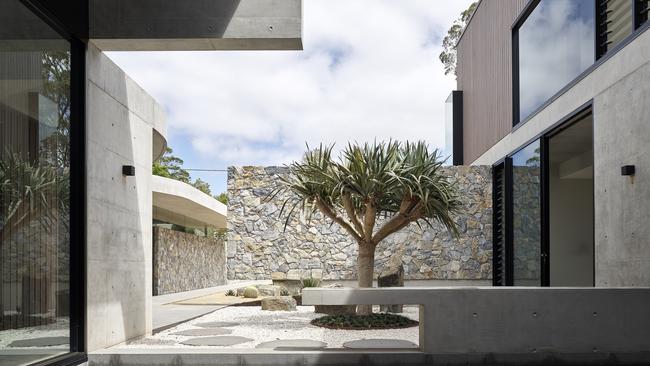
‘I have one request – no turf,” said the owner of this Toowoomba property to landscapers Jim and Micki Stewart. That might not be remarkable in hot, dry areas, but Toowoomba, west of Brisbane, is a city renowned for its benign climate, beautiful gardens and manicured lawns.
The driving force in excluding turf was to have a low-maintenance garden, but one that complemented the striking Shaun Lockyer-designed house that channels a mid-century vibe. Set on a hill, the 2470sq m property commands 180-degree views east towards Brisbane. The resulting garden won gold at the 2021 Australian Design Institute Awards, praised for its carefully thought out placement of rocks, plants and feature trees.
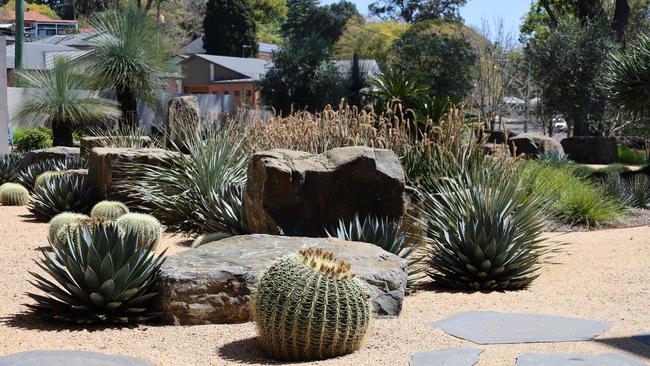
The Stewarts, who run Brisbane-based Boss Gardenscapes, were brought in at the start of the build. Jim heads up design and construction while his wife Micki leads the horticultural side. But for this project Toowoomba landscaper John Greig implemented the work and contributed local knowledge.
The selection and positioning of oversized boulders from a local quarry was paramount to setting up the backbone of the entry garden, according to Jim. “They’re magnificent specimens of grey basalt, weighing 4-6 tonnes each, with beautiful red tinges through them.” Low basalt block walls both retain and provide relaxed seating, while organic-shaped steppers of basalt are set into pathways of decomposed granite, interchanged with solid pebble paths edged with rusting steel.
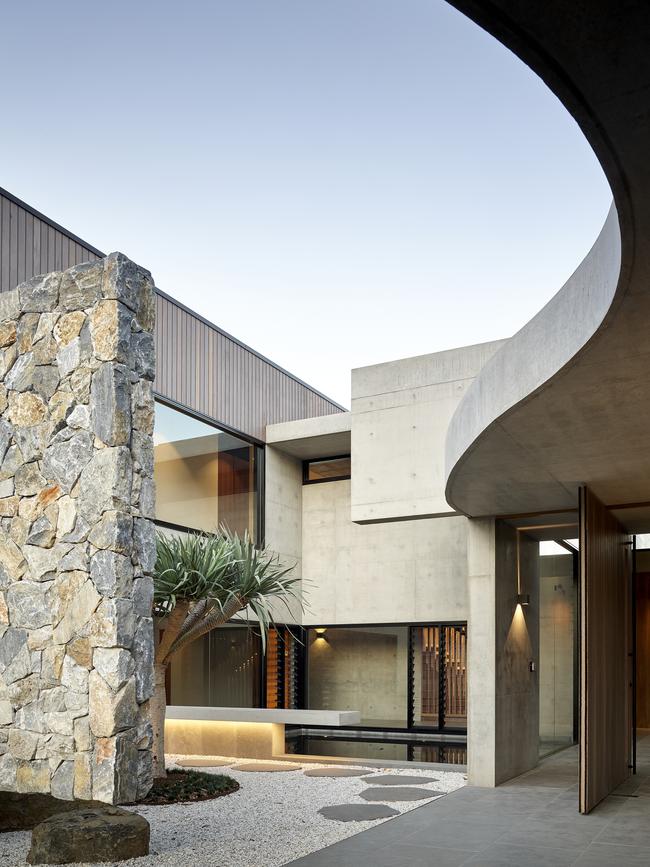
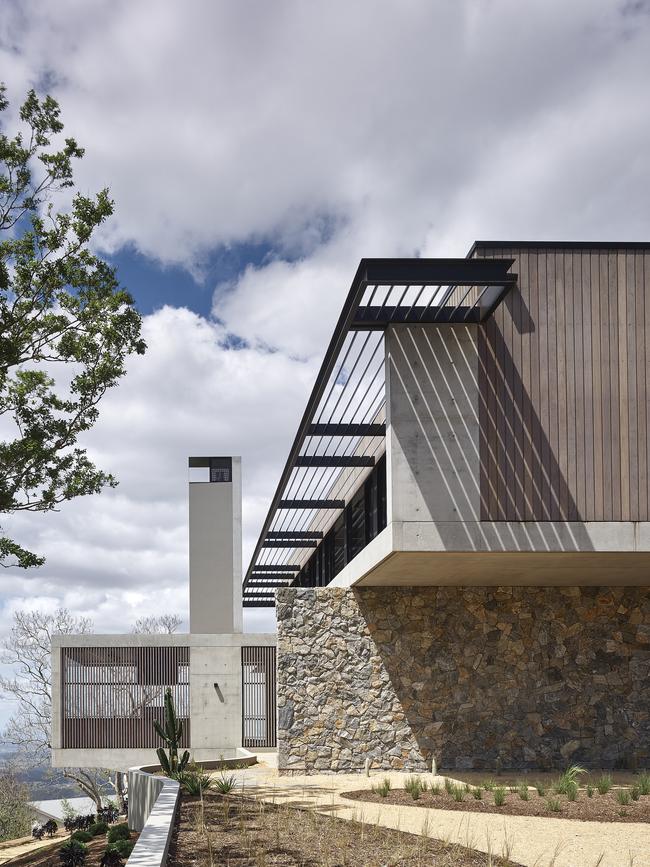
In an internal courtyard with a reflection pond, a Zen-like approach was taken with a single, sculptural dragon’s blood tree (Dracaena draco), three rocks and a blanket of pebble, creating a serene yet striking entry. Linking the swimming pool area and viewing platforms to the garden below are dramatic, floating concrete slab steps surrounded by a sea of green, blue and silver foliage.
In the arid sections, barrel cactus, Agave americana, Agave ‘Blue Glow’ and desert spoon (Dasylirion wheeleri) set the mood. Splashes of colour come from kangaroo paws and aloes.
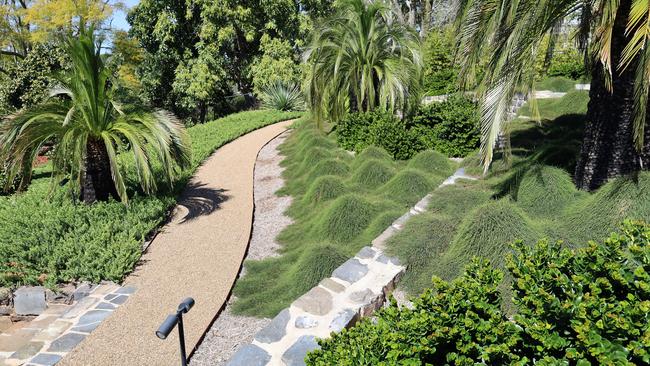
“We used a lot of groundcover plants to create living carpets of green across large areas,” explains Micki. “Dark green Juniperus taxifolia ‘Lutchuensis’ hugs the ground and stays tight, so en masse it gives the same feeling and look as turf.” Other massed groundcovers include shore juniper (Juniperus conferta), Casuarina ‘Cousin It’ and Asiatic star jasmine (Trachelospermum asiaticum).
The clients were hands-on when it came to picking the specimen trees, such as the dragon’s blood trees, a 6m-tall bottle tree (Brachychiton rupestris) and six extraordinary cycad palms (Macrozamia moorei) with thick trunks up to 3m tall, more than a century old. While these look like date palms, they’re a Queensland cycad.
“It’s not all contemporary cactuses and spiky aloes,” says Micki. “There’s a big stand of olive trees underplanted with foxtail grass (Pennisetum ‘Nafray’) to soften the outer areas of the garden, and towards the boundaries we used large stands of camellias and magnolias to ensure a sympathetic melding with the neighbours’ gardens.”
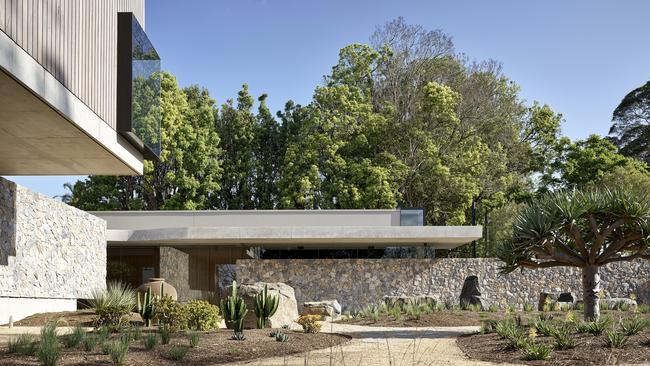
Q&A
My moth orchid (Phalaenopsis) has grown a plantlet near the top of a flower stem. Should I remove it? How can you keep moth orchids blooming? Kim Browne, by email
A “keiki” is unusual but not rare. Cut it off when it has some well-developed roots and plant into a coarse orchid mix in a pot with ample drainage holes. Moth orchids thrive in warmth (20C-30C), high humidity and bright, indirect light. Apply soluble orchid flower fertiliser monthly. A period of cooler night temperatures helps initiate new flowers after a two-month rest. New flower spikes can sprout from old ones that stay green.
Do all natives need low-phosphorus (low-P) fertiliser? B. Stephens, Sydney
Although most native plants are adapted to Australia’s low-P soils, most are not P-sensitive. For those that are, too much phosphorus causes trace element deficiencies or death. The amount of available iron is a factor. Most vulnerable are species in the Proteaceae family, many in Rutaceae and some Mimosaceae. Find out more here.

My agapanthus leaves are stunted and distorted, as were some flowers. Why? Jan Edwards, by email
Mealybug infestations are now common on agapanthus. Concealed where the leaves emerge and on roots, these white, fluffy insects damage young cells, causing twisting and stunting as leaves expand. You might see white residues on the leaves. They now seem immune to most pesticides but organic Eco-Neem mixed with Eco-Oil is effective if applied thoroughly and repeated. Eco-Neem can be used as a root drench.
Send your questions to: helenyoungtwig@gmail.com or Helen Young, PO Box 3098, Willoughby North, NSW 2068. The best question for April wins the lightweight and compact battery Shrub Shears from Stihl worth $219.


To join the conversation, please log in. Don't have an account? Register
Join the conversation, you are commenting as Logout